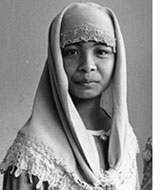text SAMIRA GUTOC

Media is often allergic to religion. But not to the Pope or the mullahs. While the former symbolizes peace, the latter represents the enemy of the 21st century. The demise of communism led the way for Islam and its proponents to be considered the new global threat, the Green Menace or Green Peril. Consider how media views the beard as against Muslim thought. Beards convey age, authority and dignity in traditional Muslim society. Western media dislikes the beard.
The Islamic world has been consistently seen as alien and exotic. The causes fought for by the Muslims have not been able to capture the attention and sympathy of Western citizens. Instead, the actions and ideology of Muslim extremists “the fundamentalists of the popular culture” are seen to represent the entire body of Muslims.
The articulate, rational voices of Islamism are therefore systematically ignored or the multiplicity of voices within Muslim communities overlooked. When television journalism chooses to engage with Islamist movements, they often concentrate on its most frustrated fringes without locating them within a broader and social context. The authorized spokesmen of the Islamic movements, who can reduce these distances, are all too often viewed as too diplomatic and are dismissed when they do not conform to stereotypes.
The Philippines is a case in point, where several Muslim anti-state groups are sometimes treated as one, under the label “Muslim,” absorbing the majority who are apolitical among them. This is contrary to one survey which notes that Muslim-Filipinos would primarily identify themselves based on ethnicity. Not sympathy to a revolutionary group.
The anomaly of generalizing Muslims has its historic roots. The Mindanao Muslim as savage is based on what Columbia University professor, the late Edward Said, would call the Cultural Other. The colonial terming of Moros to encompass all “Mohammedans” of different sultanates, overlooked the territorial, cultural distinctions of the Muslim groups in the archipelago. A prejudice against the South was entrenched soon after the arrival of the Spaniards paving the way for sporadic wars between 1565-1898. They employed the derogatory term ‘Moro’ to describe those uncivilized natives who refused to convert to Christianity and Moro “pirates” to describe the unsubjugated natives.
And because the first Muslims had an oral culture, leaving no written narrative, Philippine history with the stereotyped Moro has been taught throughout generations of Filipinos.
The Moro identity carried a stigma but during the 1980s, left-leaning Muslims in Manila carried the name to symbolize the ferocity against colonization. Decades later, Moro is no longer about being a rebel. It is an ancestry. It has transformed with modernity.
Literature has been limited by our misconceptions of minorities. Mindanao, from the point of view of those sitting in air-conditioned newsrooms across Metro Manila, is front-page when there are guns, goons and gold. Manila “the seat of economic and political power and base of all national newspapers and radio and television networks” decides what is and what is not news for the rest of the country. The We versus They stories feed into the web and international news networks thereby reinforcing age-old stereotypes.
In multi-cultural societies like the Philippines, there is a need to deepen coverage of stories beyond calamities and conflict. It is not enough to know the 5 W’s of the story. More basic is the need to provide context which gives the background on why conflicts happened in the first place. There is a need to mainstream images of ordinary Muslims. Moderate voices also need space. Many significant activities such as peace-building and development assistance are happening on the ground.
Newspapers play an important role in shaping public opinion. Consider this worrisome survey by the SWS that many Filipinos have a negative perception about the Muslims. Is media then at fault? The inability to bridge the communication gap between the Christian majority and the Muslims is clear when UNESCO recognizes the need for mass media to build commonalities and unity among Muslims and Christians. The time to open the democratic space to minorities has come.
The Moro Times is an effort to counter an elite media - to say minorities should not feel minoritized, to write news that matters, to celebrate what’s best and in the process create better harmonious communities through information exchange. It’s work that should have come a long time ago, and maybe we would have avoided the wars that cost hundreds of thousands of lives. As one speaker at the 17th World Congress of the International Catholic Union of the Press cites, “The greatest change for us journalists is our possibility to go beyond all frontiers, physical and moral, and to eliminate fear and hatred among humans.”
Subscribe Now!
![]()
View Complete Contents Of Its Maiden Issue
No comments:
Post a Comment